MIG and flux-cored wires are fundamentally different. But they both use the same wire feed mechanism and serve as filler metal, and consumable electrode in arc welding processes.
This article will teach you the essentials of MIG and flux-cored wires, their types, and why you should use one over the other.
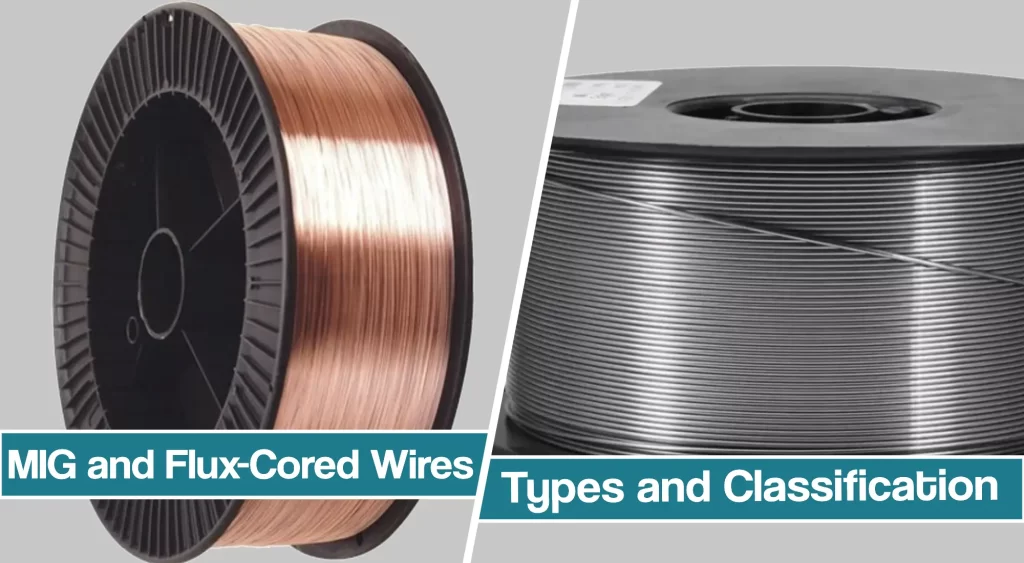
We will also discuss each type in short with a focus on the application so that you can quickly match the type of wire with your welding job.
MIG Welding Wire Types Explained
When we refer to the MIG welding wires, we discuss the solid welding wire with copper coating. Not the flux-cored wires, which are explained later in the article.
Some people may call FCAW wires gasless MIG wires, but it’s best to keep these terms separated because they are not the same.
Solid MIG welding wire is used in the GMAW welding process and requires shielding gas. Either a 100% CO2 or a 75% Argon / 25% CO2 mixture for mild steel. It’s possible to use other ratios and even add different gases but let’s stick with the basics.
This shielding gas protects the molten weld pool from atmospheric contamination, particularly from nitrogen. But if welding outdoors in windy conditions, the shielding gas will be blown away, making the solid wire less desirable.
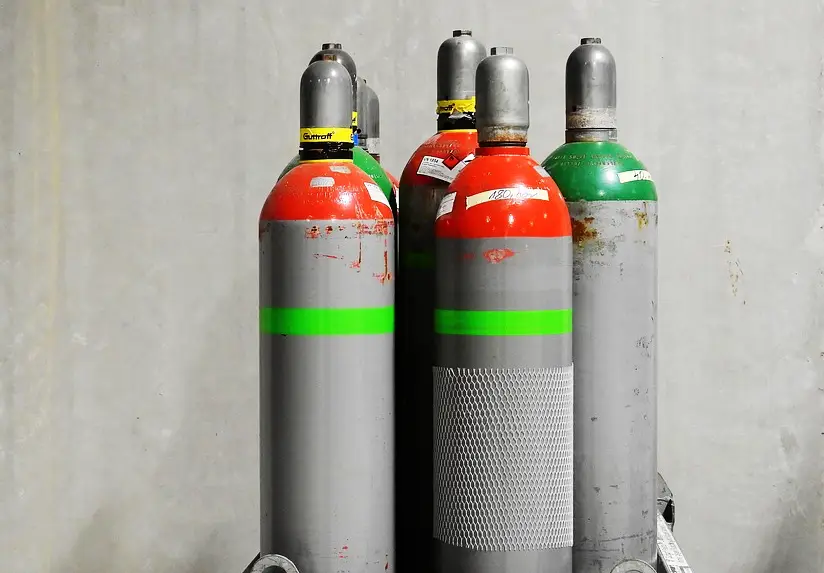
This solid wire is spooled up and fed through the MIG welding gun using a wire feeding mechanism. It’s used for welding mild steel, stainless steel, and aluminum (typically requires a spool gun).
Welding with the MIG wire produces good-looking beads (slightly inferior to TIG but much better than FCAW and stick), less spatter, and very good penetration.
It’s not a good choice for dirty metal, so you must clean the metal thoroughly before welding. The filler metal deposition rate is slower than FCAW, but it’s less likely to burn through the thin sheet metal.
There are many different sizes and MIG welding wire types. So, let’s quickly go through the MIG wire specs and then check out each type to help you find the suitable MIG wire for your project.
AWS MIG Wire Classification System
American Welding Society classifies solid MIG wires in their AWS A5.18 code. So let’s break down this classification system with one of the most commonly used solid wire electrodes like ER70S-6.
The ER70S-6 designates the following:
- ER – Electrode rod (electrode and a filler metal)
- 70 – Indicates in 1000 PSI increments the minimum tensile strength of the weld metal produced by the electrode when tested by AWS A5.18 specification. So, the number 70 here designates a tensile strength of 70,000 PSI.
- S – “S” stands for solid wire, while “C” stands for a composite wire (flux core).
- The last digit indicates the chemical additives added to the wire, which affect the resulting bead and the polarity. In this case, the number 6 means that the wire contains additional deoxidizers that help when welding rusty or dirty metal.
Commonly Used MIG Welding Wires
Let’s take a look at the most commonly used solid MIG wire and explain in short what their purpose is so that you can know which to pick for your project.
- ER70S-3 – The most commonly used general-purpose solid wire for welding mild steel. It contains silicon and manganese deoxidizers, and it’s typically used with a 75/25% argon/CO2 mix, but it can also be used with 100% CO2.
- ER70S-6 – This wire contains more deoxidizers than the ER70S-3. These deoxidizers allow it to weld slightly dirtier metal, and provide better wetting of the puddle. Additionally, you can achieve faster travel speed with it and a flatter bead profile. It is used with 75/25 ar/CO2 or 100% CO2.
- ER308, ER308L – Commonly used stainless steel MIG wire. The letter L stands for the maximum carbon content of 0.03%, which increases the resistance to intergranular corrosion.
- ER4043 – MIG wire for aluminum welding. An all-position wire used to weld heat treatable base alloys. Most commonly used for welding 6XXX series of aluminum.
- ER5356 – Aluminum MIG wire for all position non heat treatable alloys like 5XXX series when 40,000 PSI is not mandated. This is the most often used MIG wire for welding aluminum.
MIG wire chart
This is a simple MIG welding wire thickness chart with some basic and generic values for every MIG welder. Numbers might be slightly off when setting up your welding machine but you will get the general fell after a few tries.
Material Thickness | MIG Solid Wire Size | ||
| .023" | .030" | .035" | |
| 22 Gauge (.031) | / | / | |
| 20 Gauge (.037) | / | / | |
| 18 Gauge (.050) | / | / | / |
| 16 Gauge (.063) | / | / | |
| 14 Gauge (.078) | / | / | |
| 1/8" (.125) | / | / | |
| 3/16" (.188) | / | ||
| 1/4" (.25) | / | ||
Flux-Cored Wires Explained
Unlike solid MIG wire, the flux-cored wire is a tubular product with a flux filling inside its core.
The cross-section of the flux-cored wire contains of thin tube walls, which are the filler metal, and the flux inside of it, which acts as a shielding agent.
So, a flux-cored wire is something like an inverted stick electrode, but FCAW has many advantages over stick welding.
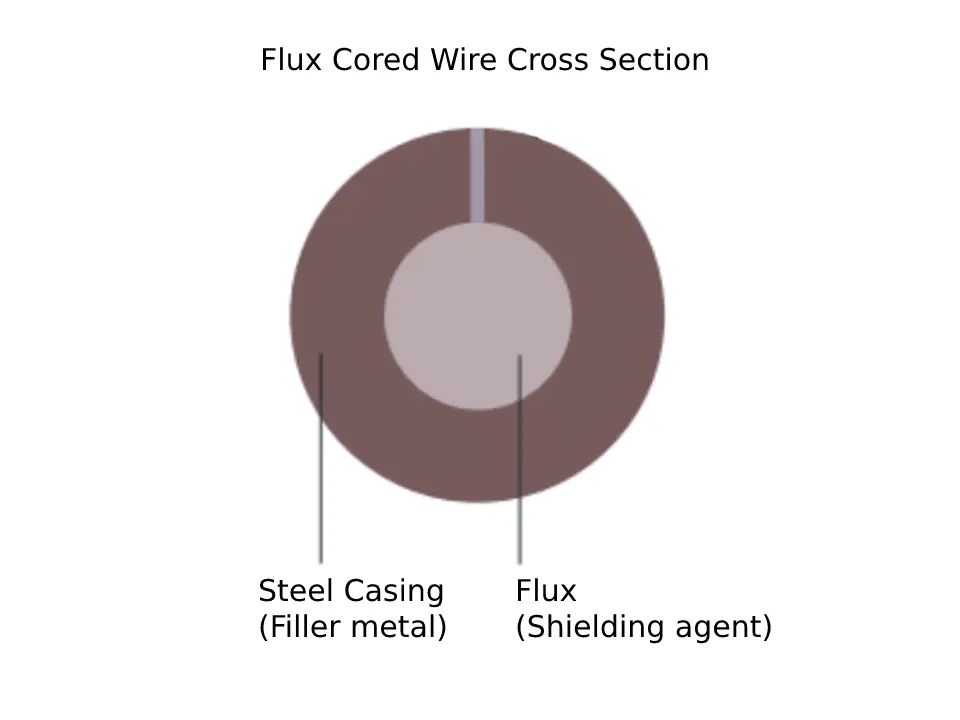
The self-shielded flux-cored wires don’t require a shielding gas like MIG solid wires because the flux on the inside forms a protective slag on the top of the weld pool, which protects the weld from nitrogen in the atmosphere and other contaminants.
In fact, the chemical composition in the flux bind with the nitrogen in the air to form the slag, effectively turning the porosity-creating agent like nitrogen into a protective element.
The advantage of flux-cored wires is the capability to weld outdoors in windy conditions because there is no shielding gas that can be blown away. Requiring no shielding gas also makes the FCAW process economical and more portable. Gas cylinders for MIG are expensive, tough to transport when welding on site is necessary, and any pressurized gas bottle is an additional safety hazard you have to deal with.
Flux-cored welding wire doesn’t create a nice-looking bead like the MIG wire. So, it’s not the best choice when the esthetics of the weld is a priority.
Additionally, it creates much more spatter and leaves a slag on top. This means much more post-welding clean-up time, which reduces your work efficiency.
Due to the thin tubular walls, the flux-cored wire has a smaller cross-section area of the metal itself. As a result, the welding current is applied to a smaller area, resulting in a significantly higher current concentration compared to MIG solid wire.
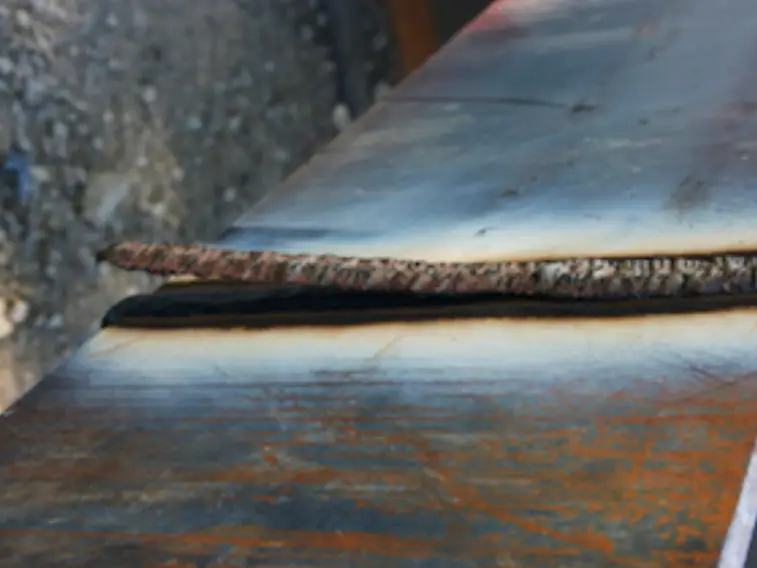
This leads to the flux-cored wire getting much hotter, having higher melt-off rates, higher metal deposition rates, and deeper penetration.
That’s why the flux-cored wire is not the best choice when welding thin gauge metal. It can easily lead to burn-through. But this makes it a great choice when welding thicker material because it will achieve much deeper penetration than the MIG wires.
WFS Range Relationships
Simple table for setting your amperage based on the MIG wire size.
| Wire Size | Amperage Range | Wire Feed Speed Range |
| .023" | 30-90 | 100-400 |
| .030" | 40-145 | 90-340 |
| .035" | 50-180 | 80-380 |
| .045" | 75-250 | 70-270 |
AWS Flux-Cored Wire Classification System
Flux-cored wires are classified under the AWS A5.20 code called Specification For Carbon Steel Electrodes For Flux Cored Arc Welding. Reading the flux wire specification is relatively simple, as shown on the example wire of E71T-GS below.
The E71T-GS signifies the following:
- E – Electrode
- 7 – Minimal tensile strength multiplied by 10,000 PSI
- 1 – The third digit can either be 0 or 1. Number “1” means that the wire is for all position welding, while number “0” classifies it for welding flat and horizontal only.
- T – Tubular
- GS – The last digit or letter presents the usability, performance, or any unique characteristics. The GS here classifies the wire as any “new” wire on the market that doesn’t fit the 1-12 classification of AWS, so it’s more open to the manufacturer’s design. Other wires will have a number of 1-12 here, and each determines what the wire is meant for. Below we covered the most commonly used flux-cored wires and their purposes.
Flux Core Wire Chart
FC wire thickness chart similar to the one above for MIG wires. Again, numbers will be slightly off from your machine because these are considered a default but it will be enough to save you some time in setting up your Flux Core welder.
Material Thickness | Gasless Flux-Cored Wire Size | ||
| .030" | .035" | .045" | |
| 22 Gauge (.031) | |||
| 20 Gauge (.037) | / | ||
| 18 Gauge (.050) | / | / | |
| 16 Gauge (.063) | / | / | / |
| 14 Gauge (.078) | / | / | / |
| 1/8" (.125) | / | / | |
| 3/16" (.188) | / | / | |
| 1/4" (.25) | / | ||
Commonly Used Flux-Cored Welding Wires
Thanks to the added compounds in the flux, the flux wire can handle more surface contaminants than solid MIG wires. But still, you should always remove as much mill scale and rust as possible.
Below are the most commonly used flux-cored wires and their AWS specifications. Just like with the MIG wires above, their names below are AWS classifications, and brands can call them differently. Just look for these numbers on the package to verify which wire it is.
- E71T-GS – An all position, single-pass flux-cored wire for welding thing gauge galvanized or mild steel. It can also weld over aluminized surfaces, and falls into a “GS” specification of AWS code which puts it as a wire that’s more open to interpretation by the manufacturer, so you should always check for details.
- E70T-6 – A general-purpose, flat and horizontal position flux-cored wire with a high deposition rate. It’s used for single and multi-pass welding applications.
- E71T-8 – This wire is designed for welding critical structural elements that must pass AWS D1.8 seismic lot waiver requirements, as well as California seismic requirements. It is characterized by penetrating arc, high deposition rates, and a fast freezing slag. The most popular brand is Lincoln with its Innershield NR-232 wire.
- E71T-11 – A common wire choice for making sound welds when making lap or butt welds, even in windy conditions. It’s a single or multi-pass wire, and produces a smooth spray arc transfer as wire melts.
Wire Diameter and MIG vs flux core
Both solid and flux-cored wires are offered in certain diameters, and each wire thickness is best used in a certain material thickness range. Larger diameter wires are meant to weld thicker metal and smaller diameter for thinner gauge.
That’s because the thicker wire applies more energy to the metal, and if you use thick wire for thin metal, you will burn through it. Below is a table of wire diameters and corresponding metal thicknesses.
Wire Quantity
Depending on workload and the type of wire feeding system used by the MIG machines, there are many options available for wire spool sizes.
For example, Lincoln Electric offers the Innershield NR-232 in wire spools ranging from 13.5 lbs to 50 lbs. While most people won’t benefit from the larger spool size, it’s economical to get the biggest spool size for your MIG welder, or a flux-cored welding machine can accommodate because it’s cheaper to buy a bigger spool once than to keep buying smaller spools.
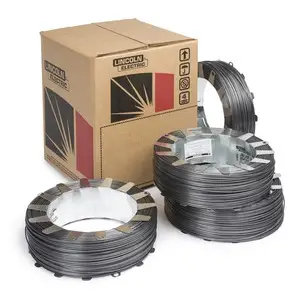
There is also the option of buying solid wire as a filler rod for TIG welding, and they are classified under the same AWS code.
Conclusion
This was a quick overview of MIG and flux-cored wires to help you understand the types and find the correct wire and wire size for your project. Keep in mind that besides the self-shielded flux-cored wires, there are also those that require an external shielding gas, but dual shield flux wires are used in the industrial setting.
A quality MIG wire is a prerequisite for making a sound weld. It influences the welding arc, weld appearance, and base metal penetration, so make sure you get a wire from a reputable brand. But the selection of shielding gases also plays a significant role when GMAW welding. FCAW takes doesn’t require the external gas tank, so when appropriate, it’s better to use it, especially when welding thicker metals.





